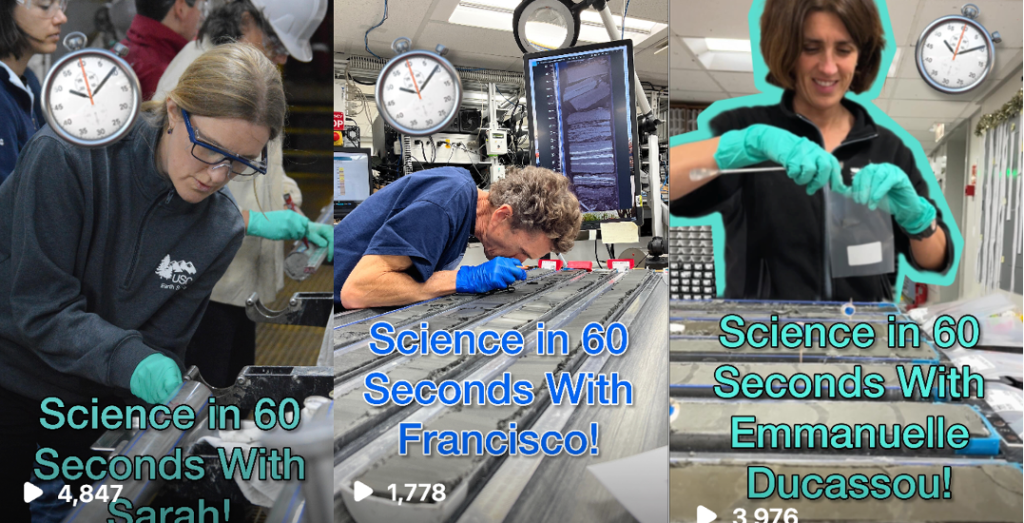
Expedition 401: Science in 60 Seconds Series
Each JOIDES Resolution expedition studies many different features of the rock cores that it pulls up with a different scientific goal in mind.
Aboard Expedition 401, we’ve recruited the scientists themselves to take on the challenge of explaining the expedition’s science and their research in 60 seconds.
What is Expedition 401 searching for?
First, get an overview of the scientific objectives of Expedition 401 from our onboard outreach officer Erin Winick Anthony.
View this post on Instagram
How can pollen help us understand the climate millions of years ago?
Expedition 401 sedimentologist Danielle Noto explains her palynology research in 60 seconds or less.
View this post on Instagram
Why did a salt giant build up in the Mediterranean?
Millions of years ago the Mediterranean got cut off from the Atlantic Ocean. Micropaleontologist Udara Amarathunga explains what happened next and why that matters to Expedition 401.
View this post on Instagram
How can microscopic fossils help us date rock cores?
Tiny fossils preserved in the cores Expedition 401 pulls from beneath the ocean floor are helping us learn about the Earth’s past climate! Micropaleontologist Moumita Das explains how!
View this post on Instagram
How does the drill on the JOIDES Resolution actually work?
The coring drill on board the JOIDES Resolution makes the science we’re doing during Expedition 401 possible. Operations Superintendent Bill Rhinehart takes on the challenge of explaining how the drill works in 60 seconds or less.
View this post on Instagram
How can Earth’s magnetic field help us find the age of rock?
Reversals of the direction of the Earth’s magnetic field and tiny dust particles are helping Expedition 401 date the age of the rock cores we’re pulling from the ground. Paleomagnetist Wout Krijsman explains how.
View this post on Instagram
How can analyzing the grains of cores can help scientists understand ocean currents millions of years ago?
Expedition 401 Co-Chief Scientist Emmanuelle Ducassou stops by to explain.
View this post on Instagram
We made it halfway!
At the halfway point of the expedition, Co-Chief Scientist Rachel Flecker stopped by the explain the scientific progress of the expedition so far. (We gave her a bit longer than 60 seconds)
View this post on Instagram
Ciencia en 60 Segundos
JOIDES Resolution expeditions are international efforts, and Expedition 401 is no exception. Meet sedimentologist Javier Hernandez Molina who is taking on the challenge of explaining his work in 60 seconds or less in Spanish!
View this post on Instagram
What are trace fossils and why are we looking for them?
Just by eating, moving, or resting, small organisms can create fossils! And that’s what sedimentologist Francisco Javier Rodriguez-Tovar is keeping an eye out for in the cores coming on deck for Expedition 401.
View this post on Instagram
What can the magnetic properties of rocks tell us about the cores we are bringing up from beneath the seafloor?
Physical properties specialist Jonathan Stine explains.
View this post on Instagram
Past climate, lipids, and… espresso?
☕️ Straight from the bridge deck of the JOIDES Resolution, organic geochemist and @uscdornsife professor Sarah Feakins explains explains how all three are connected.
View this post on Instagram
How can the shells of small creatures help us date cores?
Micropaleontologist Mohamed Zakaria Yousfi explains how they provide clues to our science team.
View this post on Instagram